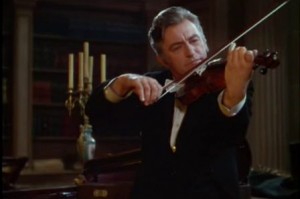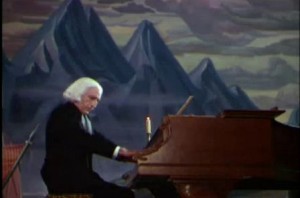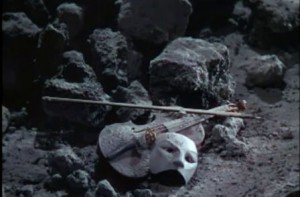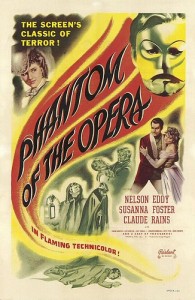The Picture That has Everything!
ROMANCE! . . . in the shadow of sinister suspense!
MUSIC! . . . that mounts to thrilling rapture!
SUSPENSE! . . . opera with death at every performance!
Some film buffs, even the most devoted, are challenged to recall many of his films, for mostly his efforts are production-line forgettable, though I’ve always liked Footsteps in the Fog. Technically, director Arthur Lubin is better known for his television work, though not particularly, even here, for high drama or the ultra profound, but rather for Westerns—Maverick in its one season—and for mindless frivolity—Mr. Ed for the eight years of its late-’50s-early-’60s run.
His link to the movies, despite such loonies as Abbott and Costello in Buck Privates and Don Knotts’ The Incredible Mr. Limpet, is the six Francis the Talking Mule films; he didn’t direct the seventh and last of the series in 1956, which was also sans Donald O’Connor as Francis’ prodigy.
Never nominated for an Oscar, Lubin’s best movie link, I believe, and why he will remain on the Hollywood map, is the—let’s see now, it’s early in the game, so it’s still easy to calculate—is the second version of The Phantom of the Opera, which has been remade at least seven times, including two TV movies and a musical rendering. True to the general history of remakes, this 1943 version remains second best to the 1925 silent original, with Lon Chaney, Sr. as Erik, The Phantom.
 Claude Rains’ character, his name Frenchified to Erique Claudin, is a violinist in the orchestra of the Paris Opéra. Because of arthritis, his playing is deemed unsatisfactory and he is let go—with a small compensation: free tickets to the opéra. His misfortune, as it will turn out, is being in love with the promising soprano understudy Christine (Susanna Foster), whose singing lessons he anonymously funds. Only casually aware of Claudin, she is wooed by two highly demonstrative men, the baritone star of the opéra Anatole (Nelson Eddy) and police detective Raoul (Edgar Barrier).
Claude Rains’ character, his name Frenchified to Erique Claudin, is a violinist in the orchestra of the Paris Opéra. Because of arthritis, his playing is deemed unsatisfactory and he is let go—with a small compensation: free tickets to the opéra. His misfortune, as it will turn out, is being in love with the promising soprano understudy Christine (Susanna Foster), whose singing lessons he anonymously funds. Only casually aware of Claudin, she is wooed by two highly demonstrative men, the baritone star of the opéra Anatole (Nelson Eddy) and police detective Raoul (Edgar Barrier).
An unusual number of films in this year, 1943, have an in-plot musical connection. Most famously, Casablanca has Rick and Elsa’s “As Time Goes By.” In Alfred Hitchcock’s Shadow of a Doubt, Uncle Charlie is haunted by a tune, a waltz from Lehár’s The Merry Widow, that has a macabre association—he murders rich widows. Two musicians combine their talents—though it’s clearly the single talent of Erich Wolfgang Korngold—to compose a short cantata, this in The Constant Nymph. Even Bernadette has her angelic song of the Virgin Mary in The Song of Bernadette, and Nazi fighter Paul Lukas is at the piano in Watch on the Rhine.
So, in Phantom Claudin has a tune for Christine, “Lullaby of the Bells,” which he includes in his piano concerto and plays in a solo violin audition for the suspicious opéra director.
 Unable to pay his rent and to make some extra money, Claudin submits his piano concerto to music publishers Pleyel and Desjardins, a legitimate firm of Ignaz Pleyel’s, though the name was actually Maison Pleyel. (Why, by the way, wouldn’t a violinist write a violin concerto? No, no—pianos, like blonds, have more fun, and it’s usually pianos and piano concertos in the movies: The Seventh Veil, Madame Sousatzka, Hangover Square, Song of Love, The Piano Teacher and The Piano and The Pianist . . . of course, there is the violin in The Red Violin and occasional other films.)
Unable to pay his rent and to make some extra money, Claudin submits his piano concerto to music publishers Pleyel and Desjardins, a legitimate firm of Ignaz Pleyel’s, though the name was actually Maison Pleyel. (Why, by the way, wouldn’t a violinist write a violin concerto? No, no—pianos, like blonds, have more fun, and it’s usually pianos and piano concertos in the movies: The Seventh Veil, Madame Sousatzka, Hangover Square, Song of Love, The Piano Teacher and The Piano and The Pianist . . . of course, there is the violin in The Red Violin and occasional other films.)
Concerned that he hasn’t heard from the publishers, Claudin returns to their shop and finds that no one knows anything about his concerto. During his protests, he hears in the next room his concerto on a piano. “You’ve stolen my concerto!” he cries. He struggles with Pleyel (Miles Mander) and one of his assistants throws a pan of etching acid into his face.
With the police in pursuit, Claudin, clutching both hands to his face, staggers outside and escapes down a street manhole. Here, in the sewers beneath the Paris Opéra, he lives and from here he haunts the theater, now donning a blue mask and purple cloak. His presence is once mistaken for the legendary ghost that supposedly inhabits the opéra. At one point, Claudin drugs the snotty diva Biancarolli (Jane Farrar) so that Christine can take her place, to great acclaim—no surprise.
The climax, during an opera performance, involves The Phantom of the Opera trademark, the crashing into the audience of the chandelier, which Claudin hacks loose from its supporting chain. In his escape, he drags Christine into the sewers, Anatole and Raoul close behind.
 As a lure for Claudin, Raoul has none other than Franz Liszt (Fritz Leiber) play Claudin’s concerto on stage after the opera. In his cavernous lair, Claudin is at a piano—in 1925 Chaney is at an organ—matching Liszt’s playing in the theater above and urging Christine to sing the lullaby that symbolizes his love for her.
As a lure for Claudin, Raoul has none other than Franz Liszt (Fritz Leiber) play Claudin’s concerto on stage after the opera. In his cavernous lair, Claudin is at a piano—in 1925 Chaney is at an organ—matching Liszt’s playing in the theater above and urging Christine to sing the lullaby that symbolizes his love for her.
The “other” climax, shared with the chandelier crash, is the unmasking of The Phantom. Claudin’s face has not been seen since before the acid toss, only his masked, cloaked figure or a shadow on the wall. Christine makes several timid attempts at removing the disguise, then finally— The scarred face is not as horrific, nor the revelation as dramatically filmed, as the 1925 version. Claudin received the acid fully in the face, but only the right side is marred.
 The sewers collapse in on themselves—inexplicably the opéra above is unscathed!—and Claudin is killed, only his violin and mask seen among the rubble. Christine is pulled to safety just in time by her two suitors.
The sewers collapse in on themselves—inexplicably the opéra above is unscathed!—and Claudin is killed, only his violin and mask seen among the rubble. Christine is pulled to safety just in time by her two suitors.
